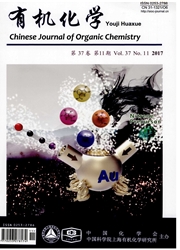

 中文摘要:
中文摘要:
Organic matrices play an important role in biomineralization process. In order to explore the effect of both meso-tetrakis (4-hydroxylphenyl) porphyrin (THPP) and hydrogels on calcium carbonate mineralization,and consequently synthesize functional materials based on porphyrin and calcium carbonate with tunable shapes and optical properties,a new kind of biomimetic mineralization system which combined THPP with three biopolymer hydrogels (gelatin,agarose and calcium alginate gels) was designed and investigated. A carbonate diffusion method based on the generation of CO2 by slow decomposition of ammonium hydrogen carbonate was adopted for calcium carbonate crystallization. The results show that both gelatin and alginate hydrogels exhibit the ability of stabilizing vaterite,while agarose only induces the formation of calcite. With participation of THPP in the mineralization environments,calcite is favored in all these hydrogels,while the crystal morphologies are greatly different from each other. These results indicate the perspective of THPP in regulating calcium carbonate crystallization and also provide a new strategy for fabricating advanced functional materials with controlled morphology and tunable optical properties based on calcium carbonate and THPP.
 英文摘要:
英文摘要:
Organic matrices play an important role in biomineralization process. In order to explore the effect of both meso-tetrakis (4-hydroxylphenyl) porphyrin (THPP) and hydrogels on calcium carbonate mineralization, and consequently synthesize functional materials based on porphyrin and calcium carbonate with tunable shapes and optical properties, a new kind of biomimetic mineralization system which combined THPP with three biopolymer hydrogels (gelatin, agarose and calcium alginate gels) was designed and investigated. A carbonate diffusion method based on the generation of CO2 by slow decomposition of ammonium hydrogen carbonate was adopted for calcium carbonate crystallization. The results show that both gelatin and alginate hydrogels exhibit the ability of stabilizing vaterite, while agarose only induces the formation of calcite. With participation of THPP in the mineralization environments, calcite is favored in all these hydrogels, while the crystal morphologies are greatly different from each other. These results indicate the perspective of THPP in regulating calcium carbonate crystallization and also provide a new strategy for fabricating advanced functional materials with controlled morphology and tunable optical properties based on calcium carbonate and THPP.
 同期刊论文项目
同期刊论文项目
 同项目期刊论文
同项目期刊论文
 Aerobic oxidation behavior of α-ionone catalyzed by N-hydroxyphthalimide combined with acetylacetone
Aerobic oxidation behavior of α-ionone catalyzed by N-hydroxyphthalimide combined with acetylacetone Synthesis, characterization and fluorescence properties of novel pyridine dicarboxylic acid derivati
Synthesis, characterization and fluorescence properties of novel pyridine dicarboxylic acid derivati Synthesis of Eu(III) and Tb(III) complexes with novel pyridine dicarboxamide derivatives and their l
Synthesis of Eu(III) and Tb(III) complexes with novel pyridine dicarboxamide derivatives and their l 期刊信息
期刊信息
